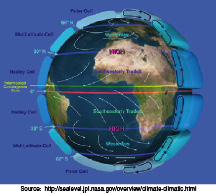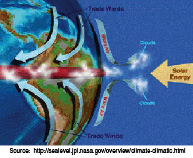

I am writing this article on
an island in the Bahamas where I have been on a small vacation with my
oldest daughter and her family. As I look toward the ocean I am
watching the culmination of a long period of movement in the earth's
atmosphere--a tropical depression named Faye that is likely to turn
into a hurricane. This island has been in desert conditions for some
time. The rocky nature has made it very difficult for even the most
hearty plants to survive. I have seen desert plants that have literally
been scorched by the hot sun at this tropical latitude in August. Now
there are sheets of welcomed rain coming down--with a prediction of
perhaps as much as ten inches of rain in the next few hours. To a
northern boy raised in Michigan, Indiana, and Ontario this is a strange
sight and a real learning situation. What many people do not seem to
understand is that this weather system is an incredibly well-designed
machine. Living things that depend on water are the prime beneficiaries
of this design.
At the equator the sun's rays strike the earth's surface at
essentially a 90 degree angle. That means energy is absorbed at the
equator more  dramatically than at any other
latitude, so it gets very hot. Contrary to what many believe, the
fundamental cause of warm and cold areas on the earth is not our
distance from the sun, the makeup of the atmosphere, clouds, or a
canopy. It is the way the sun's rays strike the earth. Hitting a
baseball perpendicularly to the bat will cause a home run, but hitting
the ball at an angle on the top of the bat will produce a foul ball. It
is very much the same situation.
dramatically than at any other
latitude, so it gets very hot. Contrary to what many believe, the
fundamental cause of warm and cold areas on the earth is not our
distance from the sun, the makeup of the atmosphere, clouds, or a
canopy. It is the way the sun's rays strike the earth. Hitting a
baseball perpendicularly to the bat will cause a home run, but hitting
the ball at an angle on the top of the bat will produce a foul ball. It
is very much the same situation.
The increased energy and heat at the equator causes the air to rise.
As it rises clouds form and rain falls to the surface of the earth and
at the equatorial latitudes causes what is called a tropical rain
forest. Once the rain has fallen the hot air is very dry and will move
away from the equator. In the earth's design, by the time it gets to 30
degrees latitude the air cools and begins to sink to the surface of the
earth. This air is very dry and the result is that a massive percentage
of the world's deserts are located at 30 degrees north or south
latitude.
As the air rises at the equator, it must be replaced, and air moving
towards the equator to replace it creates what we call the trade winds.
The air coming down at 30 degrees latitude flows both to the equator
and the opposite direction producing in the United States a prevailing
wind direction and storm direction from the southwest.
 This explanation is greatly
oversimplified. The earth's rotation exerts a force called the Coriolis
force which causes the wind to turn as it flows (see the drawing to the
left). The tilt of the earth causes the sun to be directly overhead
right at the equator only twice a year--moving as far north and south
as 23½ degrees. Oceans, continents, mountains, and even
pollution can modify this basic system but in simplified terms, this is
how it is designed.
This explanation is greatly
oversimplified. The earth's rotation exerts a force called the Coriolis
force which causes the wind to turn as it flows (see the drawing to the
left). The tilt of the earth causes the sun to be directly overhead
right at the equator only twice a year--moving as far north and south
as 23½ degrees. Oceans, continents, mountains, and even
pollution can modify this basic system but in simplified terms, this is
how it is designed.
The problem then for living things which are found at 30 degrees
latitude is how to get enough water to survive. In this journal we have
written from time to time about the individual design features of
living things that allow them to conserve or find water in arid and
inhospitable climates. The other part of the story however, is how
water balance occurs in these areas that are naturally a desert
climate. When certain areas of the oceans of the world have the sun
directly overhead, they heat up. This causes massive amounts of water
to evaporate and produces a low pressure system. We call these
low-pressure systems tropical depressions. The Coriolis force of the
earth's rotation spins these systems and consolidates them so that a
massive water machine develops over the ocean. These storms drift
across the Atlantic evaporating more water and gaining strength, and
the Coriolis force moves them up to the 30 degree north latitude. A
similar process happens in the southern hemisphere. This huge bubble of
water comes ashore as a tropical depression or hurricane. This water is
vital to the natural ecology of plants and animals native to 30 degrees
latitude.
 It is interesting that when there
are no hurricanes or tropical depressions in the 30 degree latitude
areas, the result is a problem for all living things. Drought, dropping
water tables, surface collapses, saline invasion of fresh water areas,
and a plethora of other problems cause suffering for man as well as all
other living things.
It is interesting that when there
are no hurricanes or tropical depressions in the 30 degree latitude
areas, the result is a problem for all living things. Drought, dropping
water tables, surface collapses, saline invasion of fresh water areas,
and a plethora of other problems cause suffering for man as well as all
other living things.
I am sure that there are readers of this column living in New
Orleans, Homestead, Florida, or some other place that have suffered
terrible destruction and pain from a hurricane who will object to the
portrayal of a hurricane as a design feature of the earth. We certainly
empathize with those who have suffered because of these storms, but
most of the horrific damage from these storms happens because of human
error. In the original coastal areas of North America for example,
there were massive mangrove swamps which eliminated storm surge and
blunted the effect of wind and rain. Swamps and marshes had their own
set of physical properties that minimized the damage from hurricanes.
Mankind has destroyed the mangroves, drained the swamps, and built
cities below sea level surrounded by levies. Human structures made of
light-weight materials are not going to withstand heavy wind. It is
interesting that in the Bahamas most of the buildings are made of
cement, and hurricanes are accepted as a normal event in the lives of
those who live in these islands. Hurricanes are storms that arrive
slowly with adequate warning, and need not cause the loss of human life
or significant losses of property. We have seen tragedy because of
human greed and carelessness that need not have happened.
How difficult would it be to design this weather machine? How many
variables are there in this system? The first item that has to be
designed is the miracle of water itself. Its molecular weight (18) is
less than the molecular weight of air (30) making the density change
possible to produce weather systems, evaporation, and the Hadley Cells
shown in the drawing (to the right above). The cohesive and adhesive
properties of water which are dependent on the chemical properties of
oxygen and hydrogen are essential for the processes we have been
describing. Water's high specific heat, its very high heat of
vaporization, and the most unusual closeness of its freezing and
boiling points are also critical.
From an astronomical standpoint there is a huge number of variables
that have to be carefully chosen for the system to work. The mass of
the earth controls the thickness of the earth's atmosphere. The
rotation rate of the earth allows the air masses to move properly, and
avoids the possibility that the wind velocities will go to catastrophic
levels. The gases that make up our atmosphere (primarily nitrogen and
oxygen) provide a density and set of physical and chemical factors
essential for life and for the weather systems to function. The size of
our sun, its temperature, the type of star it is, the kinds of
radiations it emits, its stability, and its distance from the earth are
all critical factors.
The point of this brief and simplified
description of how our weather systems work has been to suggest that
those who argue that a hurricane is a destructive, chance event
incompatible with the concept of a loving God is a position rooted in
ignorance. The fact is that hurricanes and the weather systems of the
earth in general are a great apologetic for the wisdom and design of
God. Human error, greed, and ignorance cause bad decisions to be made
about where and how humans build shelter from the elements. Such tragic
situations cannot be laid at the feet of God. We have an earth that is
designed so that life can live at all latitudes and in all kinds of
situations. We have been told to take care of the garden, dress it, and
keep it (
Genesis
2:15). It would seem that understanding how it works and
intelligently adapting to how it works with care and thanksgiving is
what man's lot should be--not bemoaning the consequences of bad choices
and selfish attempts to prosper from those who do not understand the
design of the system,
--John
N. Clayton
Back to Contents
Does God Exist?, MarApr09.

 I am writing this article on
an island in the Bahamas where I have been on a small vacation with my
oldest daughter and her family. As I look toward the ocean I am
watching the culmination of a long period of movement in the earth's
atmosphere--a tropical depression named Faye that is likely to turn
into a hurricane. This island has been in desert conditions for some
time. The rocky nature has made it very difficult for even the most
hearty plants to survive. I have seen desert plants that have literally
been scorched by the hot sun at this tropical latitude in August. Now
there are sheets of welcomed rain coming down--with a prediction of
perhaps as much as ten inches of rain in the next few hours. To a
northern boy raised in Michigan, Indiana, and Ontario this is a strange
sight and a real learning situation. What many people do not seem to
understand is that this weather system is an incredibly well-designed
machine. Living things that depend on water are the prime beneficiaries
of this design.
I am writing this article on
an island in the Bahamas where I have been on a small vacation with my
oldest daughter and her family. As I look toward the ocean I am
watching the culmination of a long period of movement in the earth's
atmosphere--a tropical depression named Faye that is likely to turn
into a hurricane. This island has been in desert conditions for some
time. The rocky nature has made it very difficult for even the most
hearty plants to survive. I have seen desert plants that have literally
been scorched by the hot sun at this tropical latitude in August. Now
there are sheets of welcomed rain coming down--with a prediction of
perhaps as much as ten inches of rain in the next few hours. To a
northern boy raised in Michigan, Indiana, and Ontario this is a strange
sight and a real learning situation. What many people do not seem to
understand is that this weather system is an incredibly well-designed
machine. Living things that depend on water are the prime beneficiaries
of this design. dramatically than at any other
latitude, so it gets very hot. Contrary to what many believe, the
fundamental cause of warm and cold areas on the earth is not our
distance from the sun, the makeup of the atmosphere, clouds, or a
canopy. It is the way the sun's rays strike the earth. Hitting a
baseball perpendicularly to the bat will cause a home run, but hitting
the ball at an angle on the top of the bat will produce a foul ball. It
is very much the same situation.
dramatically than at any other
latitude, so it gets very hot. Contrary to what many believe, the
fundamental cause of warm and cold areas on the earth is not our
distance from the sun, the makeup of the atmosphere, clouds, or a
canopy. It is the way the sun's rays strike the earth. Hitting a
baseball perpendicularly to the bat will cause a home run, but hitting
the ball at an angle on the top of the bat will produce a foul ball. It
is very much the same situation. This explanation is greatly
oversimplified. The earth's rotation exerts a force called the Coriolis
force which causes the wind to turn as it flows (see the drawing to the
left). The tilt of the earth causes the sun to be directly overhead
right at the equator only twice a year--moving as far north and south
as 23½ degrees. Oceans, continents, mountains, and even
pollution can modify this basic system but in simplified terms, this is
how it is designed.
This explanation is greatly
oversimplified. The earth's rotation exerts a force called the Coriolis
force which causes the wind to turn as it flows (see the drawing to the
left). The tilt of the earth causes the sun to be directly overhead
right at the equator only twice a year--moving as far north and south
as 23½ degrees. Oceans, continents, mountains, and even
pollution can modify this basic system but in simplified terms, this is
how it is designed. It is interesting that when there
are no hurricanes or tropical depressions in the 30 degree latitude
areas, the result is a problem for all living things. Drought, dropping
water tables, surface collapses, saline invasion of fresh water areas,
and a plethora of other problems cause suffering for man as well as all
other living things.
It is interesting that when there
are no hurricanes or tropical depressions in the 30 degree latitude
areas, the result is a problem for all living things. Drought, dropping
water tables, surface collapses, saline invasion of fresh water areas,
and a plethora of other problems cause suffering for man as well as all
other living things.